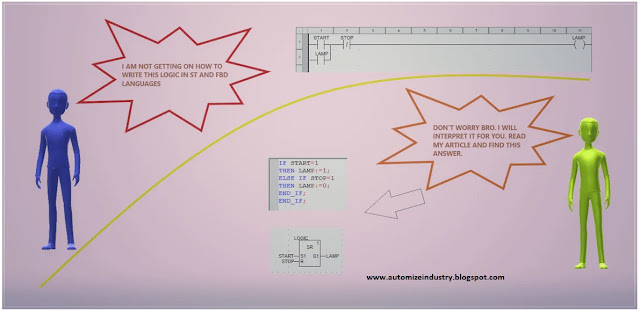Difference Between Various Electrical Panels
13 July, 2021.
In this
post, we will understand the difference between various electrical panels used
in automation and how are they linked up to control a motor.
In industrial automation, a large variety of electrical panels are used for controlling a field device and also to manage the overall load efficiency of a running plant. It is important to understand the linking and use of these panels, so that it will help engineers to design the system accordingly. In this post, we will see the various types of electrical panels and the relation between them to control the whole plant operation.
PCC panel:
The power flow starts from a PCC
panel. PCC stands for Power Control Center. This panel is the main distribution
source for the other panels in the plant. Basically, you can term it as a HT
(High Tension) panel. It is the one which is used to handle loads of more than
415V. The raw power from transformers or incomer power source is fed to PCC
panel. PCC panel is used to then feed power to various MCC panels /
transformers/ HT motors.
Refer the below image to understand the structure of PCC. A PCC
panel consists of many feeders and a busbar channel. A busbar channel is
basically a distributor of power supply to individual feeders. A feeder is an
electrical circuit which consists of components like circuit breakers,
potential transformer, current transformer, insulators and contactors. It is a
combination of control and safety circuit to provide final output voltage in a
controlled and monitored manner. Due to use of such high power involved,
protection is a main criteria before passing the voltage from busbar to it’s
destination. The protection relays and insulation levels used in PCC panels are
of a higher category than other panels.
MCC panel:
MCC meaning in electrical stands for Motor Control Center. This panel comes
after PCC panel; means it gets it’s power supply in the busbar from PCC panel.
If we see the difference between PCC and MCC panel, MCC panel can be termed as a LT (Low Tension) panel.
It is the one which is used to handle loads of less than or equal to 415V. So,
it is termed as motor control center, as it is used to provide final power to
the motors.
The arrangement of MCC panel is
same as PCC panel. It’s feeder too consists of the same components as a PCC
panel. But the power ratings and insulation ratings are lower than the ones
used in PCC panel, due to relatively low voltage used.
Basically, a major difference is also that the contactors in MCC panel feeder are controlled by a PLC or other control equipment to feed power to the motor.
Control panel (PLC Panel):
Control panel is the one which
consists of controlling elements like PLC, HMI, SCADA, meters, protection
relays and small power supplies like SMPS. The main purpose of using control
panel is to control the logic of output devices in a programmed manner. Here,
if you are interfacing a MCC panel along with it, then the PLC will control the
contactors inside the feeder to indirectly control the motor connected. The PLC
will take feedback from the feeder as digital inputs or analog inputs for
accurately controlling the feeder circuit.
Due to use of PLC’s, all the
field equipment (digital inputs, digital outputs, analog inputs and analog
outputs) are connected in this panel. VFD’s can be mounted in either the
control panel or MCC panel; depending on the requirement. Basically, if a MCC
panel is used, VFD’s must be implemented in MCC feeder for better control.
Now, apart from these basic three panels are generally used, we will some other types of electrical panels too.
IMCC Panel:
Many engineers ask what is IMCC panel? Well, IMCC stands for Intelligent Motor Control Center. This panel is same as MCC panel. But, the major difference is that a communication-enabled device called SIMICODE is used in the panel. It is a device which controls all the functions of the feeder components and has communication ports in it to send all the feedback or receive control with respect to PLC. So, the wiring for a PLC is reduced to a great extent; as only a single communication cable will control all the data flow with the MCC panel by the use of this device.
APFC Control Panels:
APFC stands for automatic power
factor control. They are used for saving power and energy. They accurately
monitor the reactive power in power systems for saving energy. They can also
alter the system voltage as well as current; which increases the efficiency of
the system.
I have covered the general types of electrical panels used in
industrial automation. I have also not attempted to cover every type of panel
deeply; you can learn it easily once you get familiar with them. I have just given
you an insight of these types of controls. A great electrical understanding is
required by the engineer who is controlling such type of system. Learn the
basics and explore a new type of study in this type of automation.
Thank you guys; I hope you enjoyed reading the
practices normally used for this type of study in industrial automation.
Read Related Article- MCCB Working Principle





I read your blog content which is very helpful for me.So i really thankful to you for this content.
ReplyDeleteElectrical And Automation
Your blog was really great and informative. Thanks for sharing your efforts with us that was amazing experience. keep sharing your knowledge.
ReplyDeleteElectrical Automation Courses
RPA
ReplyDeleteThe content of this blog is essential to learning stage people. Thanks for sharing.
RPA Training in Chennai
RPA Training Online
RPA Training In Bangalore
Nice blog...Indication Led Light Supplier in Chennai
ReplyDeleteThank you Indoor Type VCB Panel Manufacturers
ReplyDeleteVery Informative Blog Auto Phase Selector Manufacturer
ReplyDeleteVery Informative Blog Auto Phase Selector Manufacturer
ReplyDelete